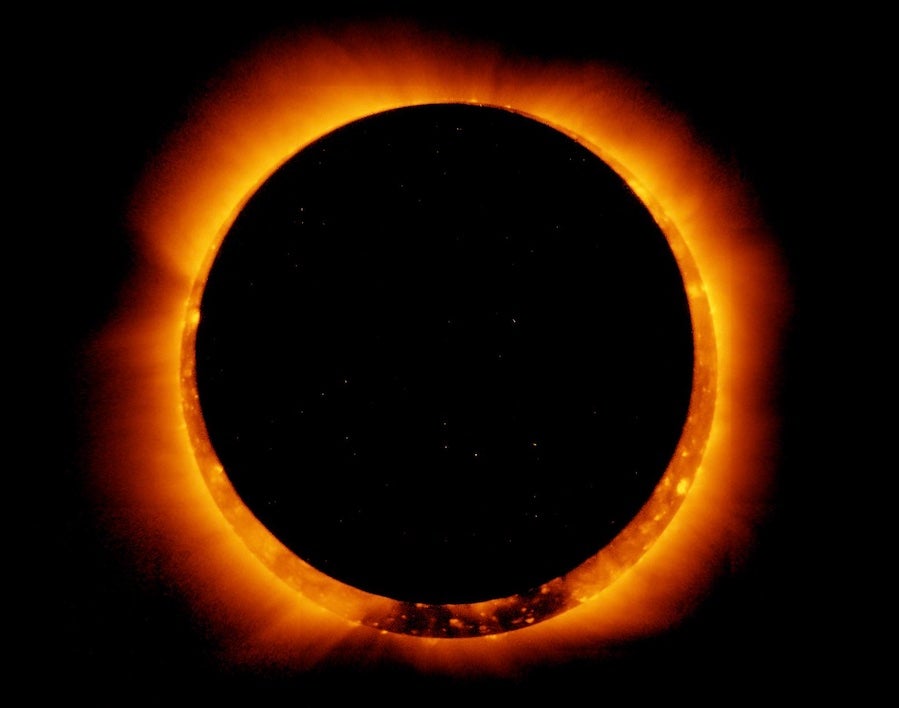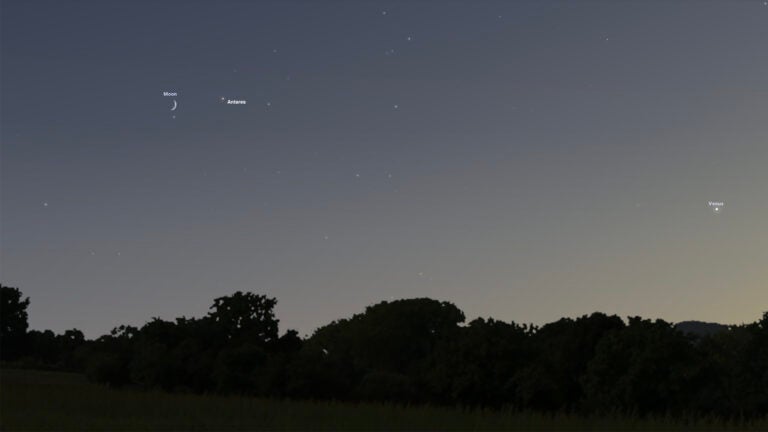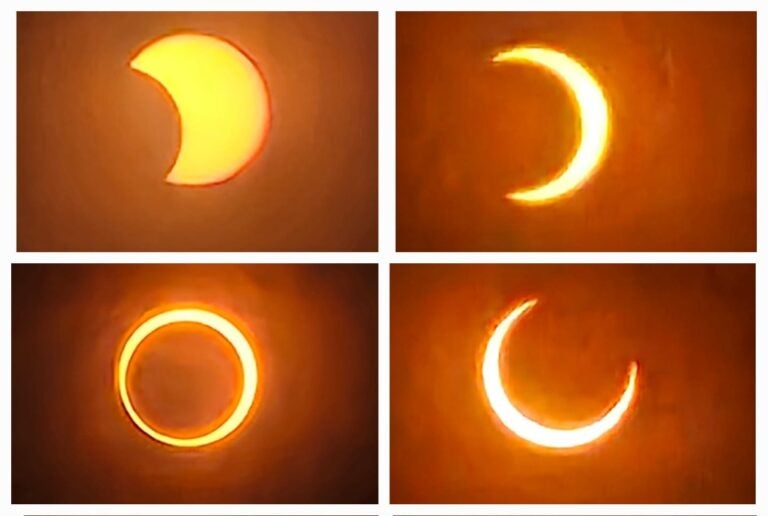
A solar eclipse is an alignment of the Sun, the Moon, and Earth — in that order. The Moon, directly between the Sun and Earth, casts a shadow on our planet. Its shadow has both an inner and an outer part. If you’re in the dark inner part of that shadow, called the umbra, you’ll see a total eclipse. If you’re in the light outer part, the penumbra, you’ll see a partial eclipse. If the Moon is far from Earth, or if Earth is close to the Sun, an annular eclipse will occur. During an annular eclipse, a ring of sunlight surrounds the Moon’s disk.
All solar eclipses happen at New Moon. The only lunar phase when the Moon is between the Sun and Earth is New Moon. But solar eclipses don’t happen at every New Moon because the Moon’s orbit tilts 5° relative to Earth’s orbit. So, the Moon’s orbit intersects Earth’s orbit in just two places. Astronomers call them nodes. Eclipses only occur when the Sun lies at one node and the Moon is at either the same node or the one on the opposite side of Earth. If the Sun and the Moon are at the same node, we’ll experience a solar eclipse. If they’re at different nodes, there will be a lunar eclipse. Most of the time, the Moon is either above or below one of the nodes, and no eclipse happens.
RELATED: 20 of the best places to see the 2024 total solar eclipse
On average, 2.38 solar eclipses of one kind or another occur each year. There must be at least two per year, but there can’t be more than five. More than 72 percent of all years have just two solar eclipses, and only 0.5 percent have five.
Similar solar and lunar eclipses repeat every 6,585.3 days, or a bit more than 18 years. Scientists call this length of time a Saros cycle. Two eclipses separated by one Saros cycle are similar. They happen with the Sun, the Moon, and Earth at the same relative positions. Also, the Moon’s distance from Earth is nearly the same, and the eclipses happen at the same time of year.
How often solar eclipses occur
A key question that often comes up is “About how often is a particular spot on Earth in the path of totality?” On average for the whole Earth, the answer is 375 years. Belgian astronomer Jean Meeus determined this some years ago. This average, however, is for all of our planet’s surface. It actually depends on whether the spot is in the Northern or Southern Hemisphere. If in the north, the answer is that a total solar eclipse occurs in a place, on average, about once every 330 years. In the south, however, it’s once per 540 years.
Although solar eclipses are just as likely to occur in the Northern Hemisphere as in the Southern, each hemisphere sees more of them during its summer — when that part of Earth is tilted toward the Sun. Now, since Earth is at the farthest point in its orbit in July (that is, during the Northern Hemisphere’s summer), the Sun’s apparent size in the sky is relatively small then.
This means that solar eclipses at that time of year are more likely to be total because the Moon is more likely to appear larger than the Sun. In other words, observers north of the equator will see more total eclipses. By similar logic, observers south of the equator should see more annular eclipses.
State Most recent totality Next totality
Alabama June 8, 1918 August 12, 2045
Alaska July 20, 1963 March 30, 2033
Arizona June 16, 1806 July 17, 2205
Arkansas June 8, 1918 April 8, 2024
California April 28, 1930 August 12, 2045
Colorado June 8, 1918 August 12, 2045
Connecticut January 24, 1925 May 1, 2079
Delaware July 29, 1478 October 26, 2144
Florida March 7, 1970 August 12, 2045
Georgia August 21, 2017 August 12, 2045
Hawaii July 11, 1991 May 3, 2106
Idaho August 21, 2017 June 25, 2169
Illinois August 21, 2017 April 8, 2024
Indiana August 7, 1869 April 8, 2024
Iowa August 21, 2017 October 17, 2153
Kansas August 21, 2017 August 12, 2045
Kentucky August 21, 2017 April 8, 2024
Louisiana June 8, 1918 August 12, 2045
Maine July 20, 1963 April 8, 2024
Maryland March 7, 1970 September 14, 2099
Massachusetts March 7, 1970 May 1, 2079
Michigan June 30, 1954 April 8, 2024
Minnesota June 30, 1954 September 14, 2099
Mississippi June 8, 1918 August 12, 2045
Missouri August 21, 2017 April 8, 2024
Montana August 21, 2017 August 23, 2044
Nebraska August 21, 2017 May 3, 2106
Nevada April 28, 1930 August 12, 2045
New Hampshire August 31, 1932 April 8, 2024
New Jersey January 24, 1925 May 1, 2079
New Mexico July 29, 1878 August 12, 2045
New York January 24, 1925 April 8, 2024
North Carolina August 21, 2017 May 11, 2078
North Dakota February 26, 1979 August 23, 2044
Ohio June 16, 1806 April 8, 2024
Oklahoma June 8, 1918 April 8, 2024
Oregon August 21, 2017 October 5, 2108
Pennsylvania January 24, 1925 April 8, 2024
Rhode Island January 24, 1925 May 1, 2079
South Carolina August 21, 2017 March 30, 2052
South Dakota June 30, 1954 August 23, 2044
Tennessee August 21, 2017 April 8, 2024
Texas May 28, 1900 April 8, 2024
Utah January 11, 1880 August 12, 2045
Vermont August 31, 1932 April 8, 2024
Virginia March 7, 1970 May 11, 2078
Washington February 26, 1979 June 25, 2169
West Virginia August 7, 1869 September 14, 2099
Wisconsin June 30, 1954 September 14, 2099
Wyoming August 21, 2017 May 3, 2106









